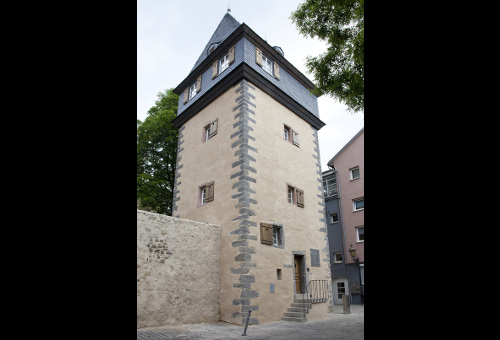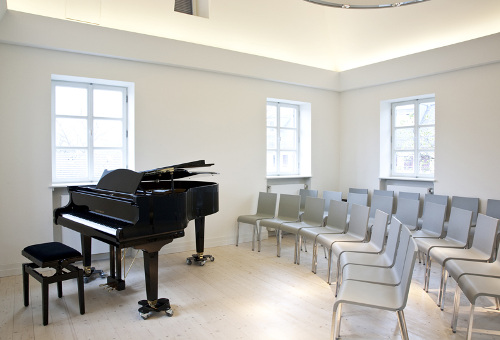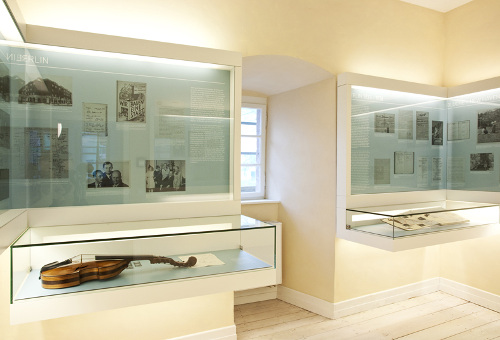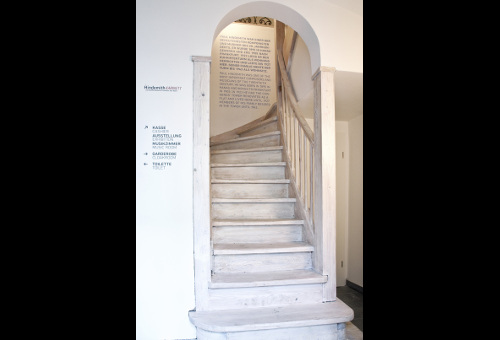





Große Rittergasse 118
60594 Frankfurt am Main
Fondation Hindemith
c/o Hindemith Institut Frankfurt
Eschersheimer Landstraße 29-39
60322 Frankfurt am Main
Telefon +49 69 597 03 62
Web: www.hindemith.info/kabinett
E-Mail: institut@hindemith.org
Sonntags 11 – 18 Uhr und nach Vereinbarung mit dem Hindemith Institut Frankfurt (069 5970362) oder dem städtischen Kulturamt (069 212-33952).
3 EUR, ermäßigt 1,50 EUR
Von 1923 bis 1927 lebte Paul Hindemith im Kuhhirtenturm im Frankfurter Stadtteil Sachsenhausen. Der gotische Wehrturm aus dem 14. Jahrhundert wurde 2011 von der Stadt Frankfurt aufwändig saniert und von der Fondation Hindemith als Erinnerungsstätte für den Komponisten eingerichtet. Heute befindet sich hier das Hindemith Kabinett mit fünf modern, hell und licht gestalteten Präsentationsräumen. Die Ausstellung zeichnet mit Originalexponaten, Reproduktionen historischer Dokumente sowie originalen Film- und Tonaufnahmen ein detailliertes Bild vom Leben und Werk des Komponisten.
Im obersten Stockwerk des Turms hatte Hindemith damals sein Musikzimmer, in das er sogar einen Flügel hieven ließ. Heute befindet sich hier der wohl kleinste Konzertsaal der Welt mit Platz für 25 Personen, in dem das Hindemith Institut Frankfurt die Konzertreihe Kammermusik im Kuhhirtenturm veranstaltet.
Das Hindemith Kabinett im Kuhhirtenturm gehört zur Dachmarke museumsuferfrankfurt.
Deutschland verfügt über musikalische Traditionen und Nachlässe von außerordentlichem Wert: Händel, Schütz und Bach, Beethoven, Mendelssohn, Schumann, Brahms und Wagner sind - um nur einige Namen zu nennen - weltweit bekannte und geschätzte Komponisten. Ihr Wirken hat eine einzigartige Musiklandschaft wesentlich mitgeformt.
Zahlreiche Orchester, Chöre und Ensembles, renommierte Musikfestivals und -reihen, Musikerhäuser mit Museen, öffentliche Archive und Bibliotheken, aber auch private Sammlungen bewahren ihr musikalisches Erbe.
Diesen unschätzbaren Fundus gilt es immer wieder neu zu beleben und für die Gegenwart zu erschließen. Den in der Arbeitsgemeinschaft Musikermuseen Deutschlands zuusammengeschlossenen Häusern kommt dabei eine wichtige Rolle zu. In ihnen begegnen wir dem Werk von Musikern und Komponisten, die die Kulturnation Deutschland außerordentlich bereichert haben. Über das individuelle Portrait, über die Vermittlung des einzelnen Œuvres hinaus tragen die Musikermuseen aber auch zur Pflege musikalischer Tradition insgesamt bei. Die vorliegende Broschüre unterstreicht diesen Aspekt der Zusammenschau, und sie lädt zu einer Reise in die Musikgeschichte Deutschlands ein. Ich wünsche diesem Reiseführer regen Gebrauch und eine große Resonanz.
Bernd Neumann, MdB
Staatsminister bei der Bundeskanzlerin
Der Beauftragte der Bundesregierung für Kultur und Medien
Zitat: Vorwort zur Broschüre der Arbeitsgemeinschaft "Musikermuseen in Deutschland", 2007.